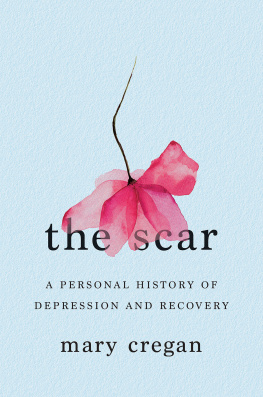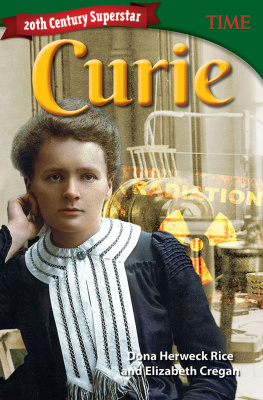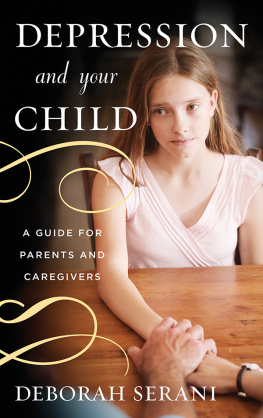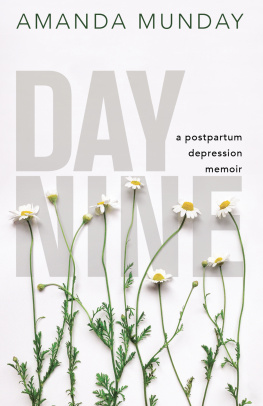Contents
Guide

The Scar

A PERSONAL HISTORY OF DEPRESSION AND RECOVERY
Mary Cregan

Copyright 2019 by Mary Cregan
All rights reserved
First Edition
Grateful acknowledgment to the following for permission to quote:
Excerpt from After great pain a formal feeling comes from The Poems of Emily Dickinson , edited by Thomas H. Johnson, Cambridge, Mass.: The Belknap Press of Harvard University Press, Copyright 1951, 1955 by The President and Fellows of Harvard College. Copyright renewed 1979, 1983 by the President and Fellows of Harvard College. Copyright 1914, 1918, 1919, 1924, 1929, 1930, 1932, 1935, 1937, 1942, by Martha Dickinson Bianchi. Copyright 1952, 1957, 1958, 1963, 1965, by Mary L. Hampson. Excerpt from Not Waving but Drowning by Stevie Smith, from Collected Poems of Stevie Smith , copyright 1957 by Stevie Smith. Reprinted by permission of New Directions Publishing Corp. Excerpts from Laments by Jan Kochanowski, translated by Stanislaw Baranczak and Seamus Heaney. Translation copyright 1996 by Stanislaw Baranczak and Seamus Heaney. Reprinted by permission of Farrar, Straus & Giroux and by permission of Faber and Faber Ltd. Excerpt from Marina from Collected Poems 19091962 by T.S. Eliot. Copyright 1936 by Houghton Mifflin Harcourt Publishing Company. Copyright renewed 1964 by Thomas Stearns Eliot. Reprinted by permission of Houghton Mifflin Harcourt Publishing Company and by permission of Faber and Faber Ltd. All rights reserved. Anthem. Words and music by Leonard Cohen. Copyright 1992 Sony/ATV Music Publishing LLC and Stranger Music Inc. All rights administered by Sony/ATV Music Publishing LLC, 434 Church Street, Suite 1200, Nashville, TN 37219. International copyright secured. All rights reserved. Reprinted by permission of Hal Leonard LLC.
For information about permission to reproduce selections from this book, write to Permissions, W. W. Norton & Company, Inc., 500 Fifth Avenue, New York, NY 10110
For information about special discounts for bulk purchases, please contact W. W. Norton Special Sales at specialsales@wwnorton.com or 800-233-4830
Book design by JAM Design
Production manager: Lauren Abbate
The Library of Congress has cataloged the printed edition as follows:
Names: Cregan, Mary, author.
Title: The scar : a personal history of depression and recovery / Mary Cregan.
Description: First edition. | New York : W.W. Norton & Company, [2019] |
Includes bibliographical references.
Identifiers: LCCN 2018050858 | ISBN 9781324001720 (hardcover)
Subjects: LCSH: Cregan, Mary,Mental health. | Depression in womenPatientsNew York (State)New YorkBiography. | Depression, MentalTreatment.
Classification: LCC RC537 .C748 2019 | DDC 616.85/270082dc23
LC record available at https://lccn.loc.gov/2018050858
ISBN: 9781324001737 (ebook)
W. W. Norton & Company, Inc., 500 Fifth Avenue, New York, N.Y. 10110
www.wwnorton.com
W. W. Norton & Company Ltd., 15 Carlisle Street, London W1D 3BS
THE SCAR is a work of nonfiction. Names (including those of all patients, as well as all physicians and others involved in the authors care) have been changed, along with certain potentially identifying details.
FOR JAMIE AND LUKE
Yet why not say what happened?
ROBERT LOWELL , Epilogue
Contents
G oing through a box of old photographs recently, I came upon one taken long ago at a baby shower in a friends New York apartment. Im seated at the center of the photograph, wearing a gray winter dress, my eight-month pregnancy mostly hidden behind the gift-box on my lap. Im twenty-seven. A small stuffed bear sits at my feet beside its crumpled wrapping paper. My husband is to my left, looking relaxed, holding a beer, and several of our college friends are in the photo as well, drinking, eating, watching me open their presents. Im holding up another gift Ive just unwrapped: a newborns onesie in white, sprinkled with tiny bears outlined in pink and blue. Looking at this young woman many years later, I feel a rush of fear and pity for her, unprepared as she is for what will unfold a few weeks later when her baby dies.
Another photograph sits on the desk where I write. It was taken thirteen years later, after a divorce and remarriage, on a visit to Arizona in the springtime. In the background, out of focus, is a blur of mountain, aspen trees, and blue sky. In the foreground, in close-up, Im hugging my rosy-cheeked nine-month-old son, his broad forehead and dark hair much like my own, his eyes lit up in a smile as his father snaps the picture. On a hike that day, I had let the baby down from his carrier to test his legs and watched him grasp the big round boulders along the side of the trail. The photograph was taken a moment later, just as Ive lifted him up, and our faces reflect the pleasure of being outdoors in the sunshine. I keep this photograph on my desk because it radiates happiness and comfort: it reminds me of what Ive been given, and how love for my husband and son continues to anchor and sustain me.
This book is about the difficult path I traveled between the moments captured in these two photographs. After the death of my infant daughter, I fell into a depression so severe and unrelenting that I was admitted to a psychiatric hospital where I nearly succeeded in taking my own life. Since then, I have never taken the fact of my existence for granted. Instead of living as I do nowteaching, writing, spending time with friends and family, taking pleasure in watching my son grow upI might be nothing more than a fading memory in the minds of those who knew me as a woman who died young, in sad and desperate circumstances. Im aware, as I remember that long-ago day of gift-giving, that my own life has been another kind of gift: a second chance. Even so, the depression that emerged so clearly at that time has never entirely left me. It is the trace of bad luck that lingers, amid so much good fortune that has come to me since.
Depression is far more widely acknowledged today than it was back then. The word depression is ubiquitous, and the disorder is toothough depression takes a variety of forms and diagnostic labels. In 2016, nearly 11 percent of Americans from eighteen to twenty-five experienced a major depressive episode (as did 9 percent of adolescents from twelve to seventeen and 6.7 percent of the general adult population). The correlation between depression and suicide is striking: the risk is significantly higher for people with mood disorders, and highest among those who have been hospitalized.
When I was diagnosed with a major depressive episode in the wake of my first childs death, I had no idea what the long-term implications of that diagnosis would be. I didnt even grasp that I was facing a long-term situation. Nobody could tell me whether my depression was the result of an inherited vulnerability, or whether it was rooted in my temperament, or my life experience, or to what extent it was a combination of all of these. Nor could even the most dedicated and sympathetic doctors provide clear answers to what seemed the simplest and most urgent questions: What exactly was depression? Why did some medications work, while others didnt? Would I ever be able to put it behind me?
Five years ago, I began trying to answer these questions, initially in an effort to understand competing claims in an ongoing debate about whether the antidepressants Id been taking for many years were merely expensive placebos. I had already read a number of memoirs and other popular books on depression, but I began to investigate the subject more widely and intensively. I had earned a doctorate in English literature and was comfortable doing research outside of the discipline in which I had been trained. And as someone who had lived with depressionand experienced the worst of itI approached medical, social, and cultural questions about the disorder and its treatment from an insiders perspective that few of the historians and scientists who have written on the subject can provide.











